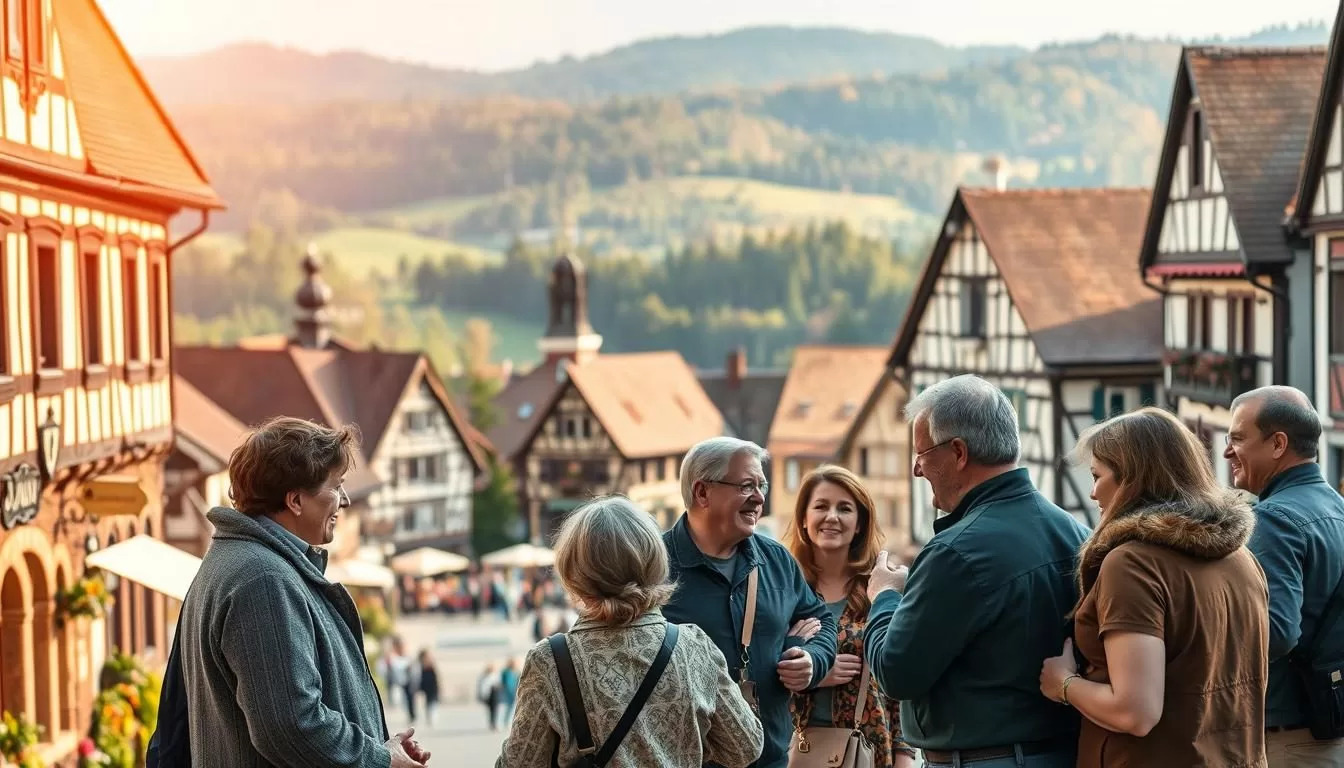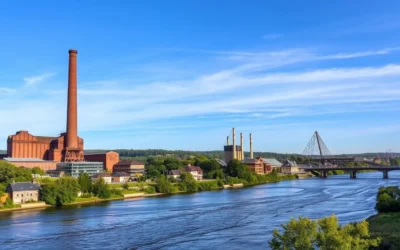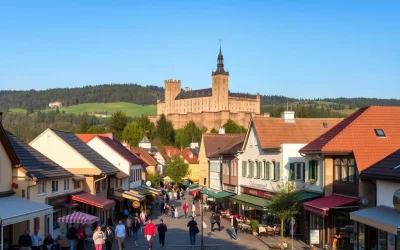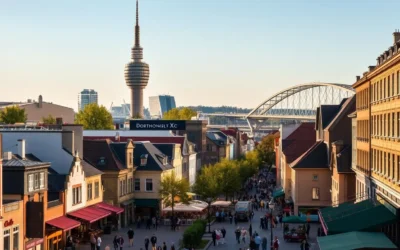✓ Accommodations✓ Flights✓ Rental Cars
When you think of cultural richness, Baden-Württemberg stands out as a vibrant state in southern Germany. Known for its innovation and historical charm, this region is a fascinating blend of tradition and modernity. Its capital, Stuttgart, is not just an economic powerhouse but also a cultural melting pot.
What makes this state truly unique is its linguistic landscape. While standard German is the primary language, the region is home to a variety of local dialects. These dialects add a distinct flavor to the cultural identity of the area. Understanding this mix of language and dialect offers you a deeper insight into its heritage.
Whether you’re exploring the bustling streets of Stuttgart or the serene countryside, the city and its surroundings reflect a harmonious blend of old and new. This linguistic diversity is a testament to the region’s rich history and dynamic present.
Overview of Baden-Württemberg’s Linguistic Heritage
Exploring the linguistic heritage of this region reveals a fascinating mix of tradition and modernity. The area is known for its diverse cultural influences, which have shaped its unique language system. From standard forms to local dialects, the region offers a rich tapestry of communication styles.
Key Language Facts for You
The system here combines standard language with regional dialects. This blend creates a dynamic linguistic environment. For example, Alemannic is widely spoken in rural areas, while urban centers often use standard forms. These facts highlight the region’s adaptability and cultural depth.
Why Language Matters in Your Experience
Understanding the local language enhances your connection to the area. It allows you to engage more deeply with its culture and people. Whether you’re exploring historic sites or interacting with locals, language bridges the gap between you and the region’s heritage.
Geographical size and neighboring borders have also played a role in shaping this linguistic landscape. The interplay between cultural identity and language offers a unique perspective on the region’s history. This makes your visit not just a trip, but a meaningful experience.
History of Languages in Baden-Württemberg
Discover how historical events shaped the words you hear today. The linguistic landscape here is a product of centuries of cultural shifts. From Roman times to modern days, each era left its mark on the way people communicate.

Historical Influences Shaping the Linguistic Landscape
Roman influences introduced Latin, which blended with local dialects. Medieval texts reveal how these early forms evolved. Key persons, like scholars and rulers, played a role in shaping the word choices we see today.
Post-war state mergers further standardized language. Schools became a driving force in teaching standard forms. This transition reflects broader global trends in language evolution.
Evolution of Language Over the Centuries
Over time, the world around this region influenced its language. Trade, migration, and cultural exchanges added new layers. The school system helped preserve and spread these changes.
Today, the language here is a blend of old and new. Historical milestones continue to shape how people speak. This evolution offers a fascinating glimpse into the region’s past and present.
Official Language Status and Regional Dialects
The linguistic landscape here is shaped by both formal structures and local traditions. Standard German serves as the primary language in governance, education, and public administration. This standardization ensures clear communication across the population, especially in official settings.
In schools, Standard German is the language of instruction. This practice dates back to educational reforms in the 18th and 19th centuries. These reforms aimed to unify the population under a common language, fostering national identity and ease of communication.
Standard German’s Role in Governance
Government documents, legal proceedings, and public services rely on Standard German. This ensures consistency and accessibility for all citizens. The history of this practice reflects broader efforts to streamline administration and foster unity.
While Standard German dominates official spaces, local dialects thrive in everyday life. This duality enriches the cultural fabric of the region. You’ll notice this blend in both urban and rural areas, offering a unique experience during your visit.
Recognizing Distinct Regional Dialects
Regional dialects, such as Swabian and Alemannic, add depth to the linguistic tapestry. These dialects are often tied to specific areas, reflecting local history and traditions. For example, Swabian is known for its unique intonation and vocabulary.
Dialects also play a role in community identity. They foster a sense of belonging among locals. While they may pose communication challenges for visitors, they also offer a glimpse into the region’s cultural richness.
| Aspect | Standard German | Regional Dialects |
|---|---|---|
| Usage | Official, education, media | Everyday conversations, local events |
| Accessibility | Widely understood | Region-specific |
| Cultural Role | Unifies the population | Preserves local heritage |
Understanding this linguistic duality enhances your connection to the area. It bridges the gap between formal and informal interactions, making your visit more meaningful. Whether you’re exploring historic sites or chatting with locals, language is your gateway to the region’s soul.
Baden-Württemberg, Germany: Official and widely spoken languages
Your journey through this region’s linguistic identity reveals a unique blend of tradition and innovation. Standard German is the primary language, but the area is also rich in local dialects. This mix creates a vibrant cultural tapestry that reflects its history and modernity.
Every town here upholds these language traditions. Schools play a key role in teaching Standard German, ensuring that every student is fluent. At the same time, local dialects are cherished and passed down through generations, adding depth to the region’s identity.
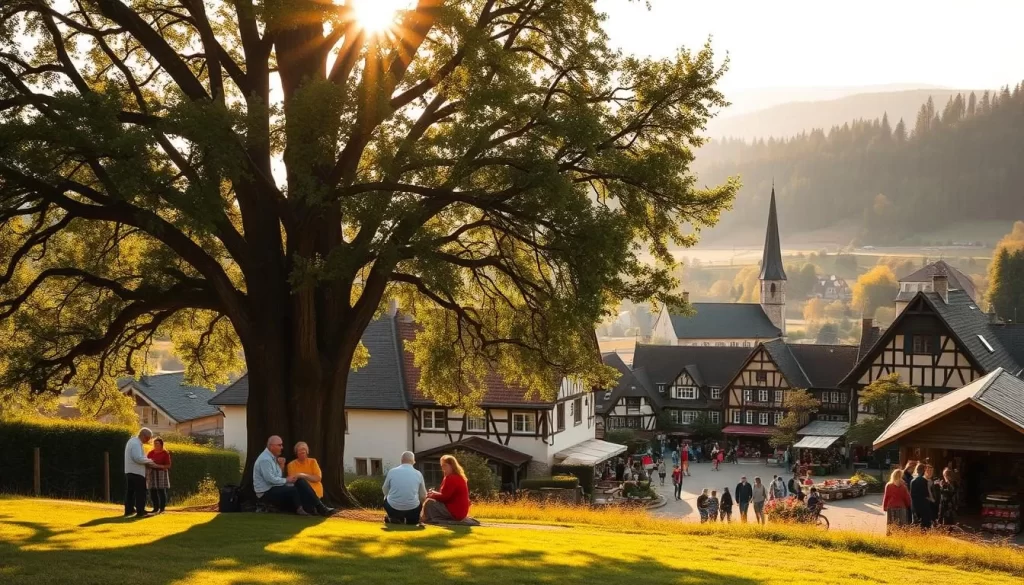
The term baden baden-württemberg captures the strong regional pride. It’s not just a name but a symbol of the area’s cultural and linguistic heritage. Whether you’re in a bustling city or a quiet place, you’ll notice this pride in everyday conversations.
- Standard German is used in education, media, and official settings.
- Local dialects like Swabian and Alemannic thrive in rural areas.
- The blend of formal and informal language use enriches the cultural experience.
This linguistic diversity is a testament to the region’s innovative spirit. It bridges the past and present, offering you a deeper connection to its heritage. Whether you’re exploring historic sites or chatting with locals, language is your gateway to understanding this vibrant place.
Linguistic Diversity Throughout the Region
Urban and rural areas here showcase distinct language patterns that reflect their social dynamics. In cities, Standard German dominates daily life, while smaller communities often preserve traditional dialects. This contrast offers a fascinating look into the region’s cultural richness.
Urban Versus Rural Language Trends
In major cities, Standard German is the primary language used in workplaces, schools, and public spaces. It ensures clear communication in fast-paced urban environments. However, rural areas often embrace local dialects like Low German and the Franconian dialect, which are deeply tied to their heritage.
These dialects are more than just ways of speaking—they’re symbols of community identity. For example, the Franconian dialect is known for its unique vocabulary and intonation. It’s a way for locals to connect with their roots and preserve traditions.
- Standard German is widely used in urban centers for formal and informal communication.
- Rural areas often favor dialects like Low German, which reflect local history and culture.
- These linguistic differences enrich everyday interactions and cultural exchanges.
Understanding these trends helps you appreciate the region’s diversity. Whether you’re in a bustling city or a quiet village, language offers a window into the local way of life.
| Aspect | Urban Areas | Rural Areas |
|---|---|---|
| Primary Language | Standard German | Local Dialects |
| Cultural Role | Modern communication | Preservation of heritage |
| Community Impact | Unifies diverse populations | Strengthens local identity |
These linguistic differences shape how people interact and connect. They highlight the region’s ability to balance modernity with tradition, offering you a richer experience during your visit.
Impact of History on Language Education and Communication
The way history shapes language education and communication is a story of resilience and adaptation. Over the centuries, shifts in culture, politics, and society have left their mark on how languages are taught and used. These influences continue to play a part in shaping modern practices.

Language in the School System
Schools have been a cornerstone in preserving and evolving language. In the late 19th century, efforts to standardize language education began, aiming to unify communication across regions. Today, this legacy is evident in the curriculum, which balances standard forms with local dialects.
For example, schools often teach a variety of languages to cater to diverse speakers. This approach ensures that students from different backgrounds feel included. It also prepares them for a globalized world where multilingualism is an asset.
Government Policies and Communication
Government policies have played a crucial role in shaping language use. Historical events, such as post-war reforms, led to the adoption of standardized language in official settings. This ensures clear and efficient communication across the population.
Today, policies continue to support linguistic diversity. Programs encourage the preservation of local dialects while promoting standard forms. This balance reflects the region’s commitment to honoring its heritage while embracing modernity.
- Historical developments have shaped modern education systems, blending tradition with innovation.
- Schools teach a variety of languages and dialects to meet the needs of diverse speakers.
- Government policies ensure efficient communication while preserving linguistic heritage.
As you explore this region, you’ll notice how historical influences remain an integral part of everyday life. From classrooms to government offices, the past continues to shape the present, offering you a deeper connection to its rich linguistic landscape.
Economic and Cultural Influences on Language
The economic strength of this region has always been a driving force behind its cultural and linguistic evolution. Companies like Mercedes-Benz, SAP, and Bosch are not just global leaders in innovation—they also shape the way people communicate and collaborate. This synergy between economic prowess and language use creates a dynamic environment where creativity thrives.
In this country, language serves as a bridge between tradition and modernity. The use of Central German and Upper German forms reflects the region’s rich heritage while supporting its role as a hub for engineering and technology. These linguistic variations are more than just dialects—they are tools for fostering innovation and cultural exchange.
Language as a Catalyst for Innovation
Economic success often fuels cultural and linguistic innovation. For example, the rise of tech giants like SAP has led to the development of specialized terminology in fields like software engineering. This new vocabulary not only enhances communication but also inspires fresh ideas and approaches.
Language also plays a key role in preserving cultural identity. While Central German forms dominate urban centers, rural areas often retain Upper German dialects. This balance ensures that the region’s heritage remains alive, even as it embraces global trends.
- The economic power of companies like Bosch drives linguistic innovation, creating new terms and concepts.
- Central German and Upper German forms reflect the region’s dual focus on tradition and progress.
- Language serves as a source of inspiration, fostering creativity in both business and culture.
| Aspect | Economic Influence | Cultural Influence |
|---|---|---|
| Language Use | Specialized terminology in tech and engineering | Preservation of regional dialects |
| Innovation | Drives new ideas and approaches | Inspires cultural exchange and creativity |
| Global Impact | Enhances international collaboration | Showcases regional identity on a global stage |
By understanding the interplay between economics and language, you gain a deeper appreciation for this region’s unique character. Whether you’re exploring its industrial hubs or cultural landmarks, language remains a vital source of connection and innovation.
Exploring Unique Regional Dialects
The linguistic diversity of this area offers a fascinating window into its cultural identity. Dialects here are more than just ways of speaking—they’re a reflection of history, community, and pride. From the rolling hills of northern germany to the bustling cities, each region has its own distinct voice.
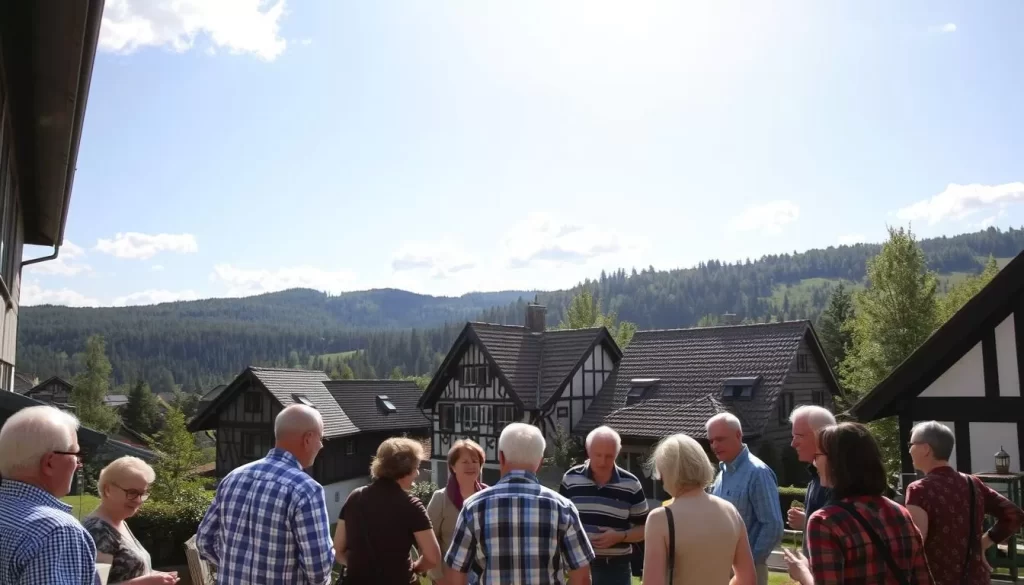
Insights into the Swabian and Bavarian Dialects
Swabian, spoken in the southwest, is known for its unique pronunciation and vocabulary. Words like Grombira (potato) and Häusle (little house) showcase its charm. The dialect’s 15 diphthongs make it sound melodic yet distinct from Standard German.
Bavarian, on the other hand, is a collection of Upper German dialects. It’s rich in regional variations, with differences in pronunciation and grammar. For example, Bavarians might say Grüß Gott instead of Guten Tag for a greeting.
A Glimpse into Alemannic and Low German Variants
Alemannic dialects, found in the southwest, are known for their soft, flowing sounds. They’re closely related to Swiss German and share many similarities. Low German, spoken in the northern germany flatlands, retains a closer connection to Old Saxon. Its simplicity and clarity make it stand out.
These dialects are influenced by historical border regions. For example, Alemannic reflects cultural exchanges with Switzerland, while Low German shows ties to the Netherlands. Today, they continue to shape local identity and pride.
| Dialect | Unique Features | Cultural Role |
|---|---|---|
| Swabian | 15 diphthongs, unique vocabulary | Reflects regional pride and heritage |
| Bavarian | Rich variations, distinct greetings | Strengthens community identity |
| Alemannic | Soft sounds, Swiss German ties | Preserves cultural exchanges |
| Low German | Simple, Old Saxon roots | Highlights historical connections |
In case you’re curious, these dialects often appear in everyday conversations. For instance, a Swabian might say Schaffe, schaffe Häusle baue to emphasize hard work. These phrases offer a glimpse into the local mindset and values.
Understanding these dialects enriches your visit. They’re not just words—they’re a bridge to the region’s soul. Whether you’re in a bustling city or a quiet village, dialects connect you to the heart of the community.
The Role of Migration in Shaping the Linguistic Landscape
Migration has always been a powerful force in shaping the way people communicate. As groups move from one place to another, they bring their language and dialects with them. This exchange enriches the linguistic landscape, creating new variants and blending traditions.
Historical migration patterns, such as post-war emigration, played a significant role in this process. For example, between 1950 and 2005, over 1.5 million people moved from Poland to Germany. This movement introduced new dialect german features and influenced local speech patterns.
How Emigration Brought New Language Trends
When people leave their home, they carry their language as a piece of their identity. Migrant groups often preserve their dialects while adapting to new environments. Over time, these variants evolve, blending with local languages to create unique forms of communication.
For instance, the term Aussiedler describes German minorities who returned from east-central Europe. Their integration into society brought new linguistic elements, enriching the region’s cultural fabric. This exchange highlights the enduring link between people’s origins and their evolving language patterns.
- Migration introduces new language trends, blending traditions and creating fresh variants.
- Migrant groups preserve their dialects while adapting to new environments, influencing local speech.
- Emigration from home regions helps disseminate language features across borders.
- Concrete examples, like the Aussiedler, showcase the impact of migration on language.
| Aspect | Impact |
|---|---|
| Migration Patterns | Introduce new dialect german features and enrich local languages. |
| Migrant Groups | Preserve and adapt their dialects, creating unique variants. |
| Cultural Exchange | Blend traditions, fostering a dynamic linguistic landscape. |
Understanding the role of migration helps you appreciate the region’s linguistic diversity. It’s a story of connection, adaptation, and the enduring power of language to unite people across borders.
Modern Communication and Language in Education
In today’s digital age, communication and education are evolving at an unprecedented pace. Digital media is transforming how languages are taught and learned, making it easier for you to access resources and connect with others. This shift is particularly evident in the territory, where innovative programs are reshaping language education.
Digital Media and Evolving Language Use
Digital platforms like apps, podcasts, and online courses are revolutionizing language learning. These tools allow you to practice anytime, anywhere. In major cities like Stuttgart and Mannheim, schools are integrating technology into their curricula. This approach not only enhances learning but also prepares students for a globalized world.
“Technology is not just a tool; it’s a bridge to new ways of learning and communicating.”
For example, interactive apps make vocabulary building fun and engaging. Podcasts offer real-life conversations, helping you understand accents and dialects. These resources are transforming the territory into a hub for modern language education.
Enhancing Learning Through Language Exposure
Modern educational programs are designed to broaden your language exposure. Schools in the territory are adopting immersive techniques, such as bilingual classrooms and cultural exchange projects. These methods help you connect with the language on a deeper level.
- Interactive apps make learning accessible and engaging.
- Podcasts and videos provide real-world language exposure.
- Bilingual classrooms foster fluency and cultural understanding.
In major cities, institutions are leveraging technology to create dynamic learning environments. For instance, virtual reality (VR) is being used to simulate real-life scenarios, enhancing your ability to communicate effectively.
| Aspect | Traditional Methods | Modern Techniques |
|---|---|---|
| Accessibility | Limited to classroom settings | Available anytime, anywhere |
| Engagement | Textbooks and lectures | Interactive apps and VR |
| Cultural Exposure | Minimal | Immersive and diverse |
By embracing both traditional and modern methods, you gain a well-rounded understanding of the language. This blend of old and new ensures that your learning experience is both meaningful and effective. To learn more about the evolution of the German language, visit this resource.
German Language’s Global Influence
The German language has left a significant mark on global communication and culture. With over 95 million native speakers and 80-85 million second-language learners, it is one of the most widely spoken languages in the world. Its influence extends far beyond Europe, shaping fields like science, technology, and literature.
Standard German’s Worldwide Reach
Standard German serves as a unifying force across German-speaking countries. Its standardized form ensures clear communication in international settings. Over time, changes in language use have made it a preferred variant for global interactions.
The government plays a crucial role in promoting German abroad. Programs like the Goethe-Institut support language learning and cultural exchange. These efforts help maintain German’s relevance in a rapidly globalizing world.
- German is the third most taught foreign language in continental Europe.
- It ranks second in scientific publications, showcasing its importance in research.
- German-speaking countries account for 10% of all books published worldwide.
| Aspect | Global Impact |
|---|---|
| Science | Second most used language in research publications. |
| Literature | Fifth in annual publication of new books. |
| Education | Third most learned second language in the U.S. |
German’s contributions to international literature and technology are undeniable. From the works of Goethe to innovations by German engineers, the language continues to inspire. Its widely spoken status ensures its place in global conversations.
Understanding the change in language use over time helps you appreciate its global reach. Whether you’re exploring its literary heritage or its role in modern science, German offers a unique perspective. Embrace its worldwide influence and discover its lasting impact.
Practical Ways to Embrace the Local Language Culture
Engaging with the local language culture offers a unique way to connect with the region’s heritage. Whether you’re a traveler or a language enthusiast, immersing yourself in dialects can enrich your experience. Here are some practical tips to help you explore and enjoy the linguistic diversity firsthand.
Tips to Explore Local Dialects on Your Visit
Start by visiting local markets and community events. These are great places to hear dialects in action and interact with locals. Museums dedicated to regional heritage often showcase language exhibits, giving you a deeper understanding of its evolution.
For a more structured experience, consider joining guided tours or language cafés. These services provide opportunities to learn and practice dialects in a supportive environment. They’re especially helpful if you’re new to the area or want to dive deeper into the culture.
- Visit local markets and festivals to hear dialects in everyday use.
- Explore museums that highlight regional language heritage.
- Join guided tours or language cafés for expert insights and practice.
The best time to interact with locals is during community events or festivals. These gatherings are perfect for experiencing dialects in a lively, authentic setting. Don’t hesitate to ask questions—locals often appreciate your interest in their language.
Taking an active role in exploring dialects can make your visit more meaningful. Whether it’s through conversations, cultural activities, or educational services, embracing the local language culture is a rewarding way to connect with the region’s soul.
Conclusion
Language is more than just words—it’s a reflection of history, culture, and innovation. In this region, the blend of engineering marvels and local dialect traditions creates a vibrant linguistic tapestry. From historical shifts to modern communication, every word tells a story.
Understanding this diversity enriches your experience. Whether you’re exploring urban centers or rural areas, the local dialect offers a unique window into the community’s soul. It’s a testament to the region’s ability to balance tradition with progress.
As you reflect on the interplay of history, migration, and innovation, consider how language shapes identity. The engineering of culture through words is a powerful force. Embrace this heritage on your next visit, and let the language guide you to a deeper connection.
In the end, language is a bridge—a way to connect with the past, present, and future. By appreciating its nuances, you gain a richer understanding of the world around you.
The above is subject to change.
Check back often to TRAVEL.COM for the latest travel tips and deals.
